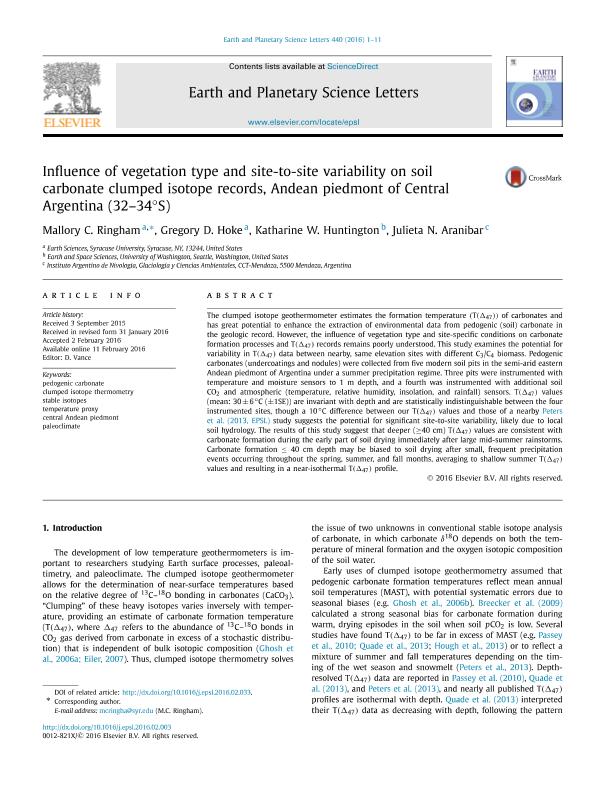Mostrar el registro sencillo del ítem
dc.contributor.author
Ringham, Mallory C.
dc.contributor.author
Hoke, Gregory D.

dc.contributor.author
Huntington, Katharine W.
dc.contributor.author
Aranibar, Julieta Nelida

dc.date.available
2022-12-29T14:45:42Z
dc.date.issued
2016-04
dc.identifier.citation
Ringham, Mallory C.; Hoke, Gregory D.; Huntington, Katharine W.; Aranibar, Julieta Nelida; Influence of vegetation type and site-to-site variability on soil carbonate clumped isotope records, Andean piedmont of Central Argentina (32-34°S); Elsevier Science; Earth and Planetary Science Letters; 440; 4-2016; 1-11
dc.identifier.issn
0012-821X
dc.identifier.uri
http://hdl.handle.net/11336/182825
dc.description.abstract
The clumped isotope geothermometer estimates the formation temperature (T(Δ47)) of carbonates and has great potential to enhance the extraction of environmental data from pedogenic (soil) carbonate in the geologic record. However, the influence of vegetation type and site-specific conditions on carbonate formation processes and T(Δ47) records remains poorly understood. This study examines the potential for variability in T(Δ47) data between nearby, same elevation sites with different C3/C4 biomass. Pedogenic carbonates (undercoatings and nodules) were collected from five modern soil pits in the semi-arid eastern Andean piedmont of Argentina under a summer precipitation regime. Three pits were instrumented with temperature and moisture sensors to 1 m depth, and a fourth was instrumented with additional soil CO2 and atmospheric (temperature, relative humidity, insolation, and rainfall) sensors. T(Δ47) values (mean: 30±6°C (±1SE)) are invariant with depth and are statistically indistinguishable between the four instrumented sites, though a 10 °C difference between our T(Δ47) values and those of a nearby Peters et al. (2013, EPSL) study suggests the potential for significant site-to-site variability, likely due to local soil hydrology. The results of this study suggest that deeper (≥40 cm) T(Δ47) values are consistent with carbonate formation during the early part of soil drying immediately after large mid-summer rainstorms. Carbonate formation ≤ 40 cm depth may be biased to soil drying after small, frequent precipitation events occurring throughout the spring, summer, and fall months, averaging to shallow summer T(Δ47) values and resulting in a near-isothermal T(Δ47) profile.
dc.format
application/pdf
dc.language.iso
eng
dc.publisher
Elsevier Science

dc.rights
info:eu-repo/semantics/openAccess
dc.rights.uri
https://creativecommons.org/licenses/by-nc-nd/2.5/ar/
dc.subject
CENTRAL ANDEAN PIEDMONT
dc.subject
CLUMPED ISOTOPE THERMOMETRY
dc.subject
PALEOCLIMATE
dc.subject
PEDOGENIC CARBONATE
dc.subject
STABLE ISOTOPES
dc.subject
TEMPERATURE PROXY
dc.subject.classification
Geología

dc.subject.classification
Ciencias de la Tierra y relacionadas con el Medio Ambiente

dc.subject.classification
CIENCIAS NATURALES Y EXACTAS

dc.title
Influence of vegetation type and site-to-site variability on soil carbonate clumped isotope records, Andean piedmont of Central Argentina (32-34°S)
dc.type
info:eu-repo/semantics/article
dc.type
info:ar-repo/semantics/artículo
dc.type
info:eu-repo/semantics/publishedVersion
dc.date.updated
2022-12-27T18:16:39Z
dc.journal.volume
440
dc.journal.pagination
1-11
dc.journal.pais
Países Bajos

dc.journal.ciudad
Amsterdam
dc.description.fil
Fil: Ringham, Mallory C.. Syracuse University; Estados Unidos
dc.description.fil
Fil: Hoke, Gregory D.. Syracuse University; Estados Unidos
dc.description.fil
Fil: Huntington, Katharine W.. University of Washington; Estados Unidos
dc.description.fil
Fil: Aranibar, Julieta Nelida. Consejo Nacional de Investigaciones Científicas y Técnicas. Centro Científico Tecnológico Conicet - Mendoza. Instituto Argentino de Nivología, Glaciología y Ciencias Ambientales. Provincia de Mendoza. Instituto Argentino de Nivología, Glaciología y Ciencias Ambientales. Universidad Nacional de Cuyo. Instituto Argentino de Nivología, Glaciología y Ciencias Ambientales; Argentina
dc.journal.title
Earth and Planetary Science Letters

dc.relation.alternativeid
info:eu-repo/semantics/altIdentifier/doi/http://dx.doi.org/10.1016/j.epsl.2016.02.003
dc.relation.alternativeid
info:eu-repo/semantics/altIdentifier/url/https://www.sciencedirect.com/science/article/pii/S0012821X16300140
Archivos asociados
